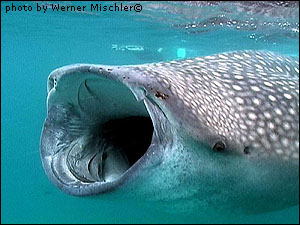WHALE SHARK FOOD HABITS
Whale Sharks feed on wide variety of planktonic (microscopic) and nektonic (larger free-swimming) prey, such as small crustaceans, schooling fishes, and occasionally on tuna and squids. Also, phytoplankton (microscopic plants) and macroalgae (larger plants) may form a component of the diet.
Unlike most plankton feeding vertebrates, the whale shark does not depend on slow forward motion to operate its filtration mechanism. Rather, it relies on a versatile suction filter-feeding method, which enables it to draw water into the mouth at higher velocities than these dynamic filter-feeders, like the basking shark. This enables the whale shark to capture larger more active nektonic prey as well as zooplankton aggregations. Therefore, the whale shark may be more dependent on dense aggregations of prey organisms.
The denser filter screens of this shark act as more efficient filters for short suction intakes, in contrast to the flow through systems of basking shark. Whale sharks are always seen feeding passively in a vertical or near vertical position with the head at or near the surface.
 The whale shark feeds actively by opening its mouth, distending the jaws and sucking. Than it closes its mouth and the water flow out its gills. During the slight delay between closing the mouth and opening the gill flaps, plankton may be trapped against the dermal denticles lining the gill plates and pharynx.
The whale shark feeds actively by opening its mouth, distending the jaws and sucking. Than it closes its mouth and the water flow out its gills. During the slight delay between closing the mouth and opening the gill flaps, plankton may be trapped against the dermal denticles lining the gill plates and pharynx.
The fine sieve-like apparatus, a unique modification of the gill rakers, forms an obstruction to the passage of anything but fluid, retaining all organisms above 2 to 3mm in diameter. Practically nothing but water goes through this sieve.
Individuals have also been observed coughing, a mechanism that is thought to be employed to clear or flush the gill rakers of accumulated food particles. Whale sharks move their heads from side to side, vacuuming in seawater rich in plankton, or aggressively cut swathes through schools of prey.
Groups of individuals have been observed feeding at dusk or after dark. The density of plankton probably is sensed by the well-developed nostrils, located on either side of the upper jaw, on the leading edge of the terminal mouth. The frequent turns may keep the whale sharks in the denser parts of the plankton patches, searching and scanning when an olfactory cue weakens on one side or the other.
The whale shark’s small eyes are located back on the sides of the head. Because of this, vision may play a much smaller role than olfaction in directing the head turns during surface feeding. One live whale shark pup removed from its dead mother was maintained in captivity in Japan. It did not eat for the first 17 days, even though it swam constantly. This suggests that the pup had substantial stores of endogenous (stored) energy.






